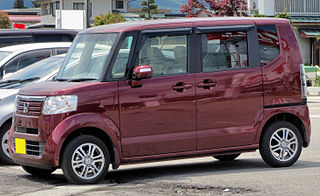
Kei car is the smallest category of Japanese, expressway-legal motor vehicles. 'Kei' is diminutive for kei-jidōsha,, "light automobile" or "compact automobile". With restricted dimensions and engine specifications, owners benefit firstly from lower taxes and insurance rates which lead to a lower overall cost of ownership. And in most rural areas, importantly, they were also exempted from the general Japanese shako shōmeisho (車庫証明書) parking-space ownership requirement to legally buy a motor vehicle at all, as street parking is generally restricted in Japan. Japan's carmakers also make microvans and kei trucks within this legal category.

The Mazda Carol is a kei car manufactured by Mazda from 1962 until 1970. The Carol name was revived again with Mazda's 1989 re-entry into the kei car class with the Autozam brand. Since 1989, the Carol has been a rebadged model manufactured by Suzuki for Mazda, based on the Japanese Suzuki Alto. The first two generations of the modern era Carols received unique bodywork, but since late 1998 the nameplate has been strictly a badging exercise.
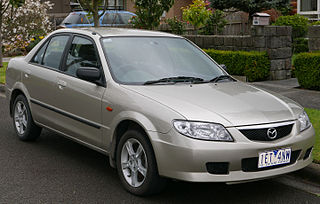
The Mazda Familia, also marketed prominently as the Mazda 323, Mazda Protegé and Mazda Allegro, is a small family car that was manufactured by Mazda between 1963 and 2003. The Familia line was replaced by the Mazda3/Axela for 2004.

The Mazda Bongo, also known as Mazda E-Series, and the Ford Econovan, is a cabover van and pickup truck manufactured by the Japanese automobile manufacturer Mazda since 1966. The Bongo name was also used for the Bongo Friendee, which is not a cabover design.
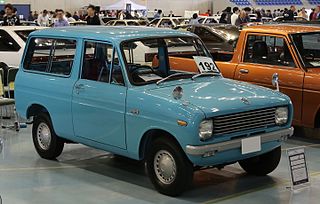
The Mazda Porter and Porter Cab are a series of small kei trucks that were produced from 1961 to 1989 by Mazda, mainly for sale in the domestic Japanese market. Export versions of the Porter were labelled E360. The Porter was replaced by the Autozam Scrum, a rebadged Suzuki Carry.

The Subaru Rex, also known as Ace, Viki, Sherpa, 500/600/700, Mini Jumbo, Mini Subaru or M60/M70/M80 in various export markets, is a kei class automobile produced from 1972 to 1992 mainly for sale in Japan by Subaru, although it was also sold in Europe, South America, Australia and the Caribbean. The Rex superseded the R-2 as Subaru's kei car, and has been available in commercial use versions as well as in a passenger car version. It underwent major changes in 1976, in fall 1981, and again in late 1986. The second generation Rex (1981–1986) also formed the basis for the larger Subaru Justy.
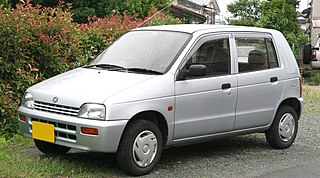
The Suzuki Alto is a kei car produced by Suzuki since 1979. The model, currently in its ninth generation, was first introduced in 1979 and has been built in many countries worldwide. The Alto originated as a commercial vehicle derivative of the Fronte, but over time the Alto nameplate gained in popularity and by 1988 it replaced the Fronte name completely. The Alto badge has often been used on different cars in Japan and in export markets, where it is considered a city car.

The Subaru Leone is a compact car produced by the Japanese car manufacturer Subaru from 1971 to 1994. The word leone is Italian for lion.
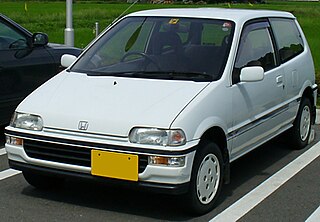
The Honda Today is a kei car produced by Japanese automaker Honda beginning in 1985. It was replaced by the Honda Life in 1998.

The Suzuki Wagon R is a kei car manufactured and marketed by Suzuki since 1993. The R in the name stands for Revolution and Relaxation. The Wagon R uses a "tall wagon" configuration to maximize cabin space within kei car dimensional restrictions. The Wagon R is also sold by Mazda as the AZ-Wagon from 1994 to 2012 and as the Flair from 2012.
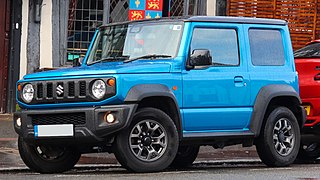
The Suzuki Jimny is a series of four-wheel drive off-road mini SUVs, manufactured and marketed by Japanese automaker Suzuki since 1970.

The Daihatsu Hijet is a cab over microvan and kei truck produced and sold by the Japanese automaker Daihatsu since 1960. Despite the similarities between the Hijet name and Toyota's naming scheme for its trucks and vans, the name "Hijet" has been in use for Daihatsu's kei trucks and microvans since 1960, over two decades before Toyota took control. "Hijet", when transliterated into Japanese, is very similar to "Midget", one of Daihatsu's other mini-trucks. According to Daihatsu, the name "Hijet" was created to imply that the vehicle offers higher performance than the Midget. The Hijet competes in Japan with the Honda Acty, Mitsubishi Minicab, Nissan Clipper, Subaru Sambar and Suzuki Carry.

The Honda Acty is a series of cabover microvans and kei trucks produced by the Japanese automaker Honda from 1977 to 2021, designed for the Japanese domestic market (JDM). "Acty" is short for "Activity".

The Subaru Sambar is a cabover truck and microvan manufactured and marketed by Subaru as Japan's second truck compliant with the country's strict Keitora (軽トラ) or Kei vehicle tax class, after the Kurogane Baby. Introduced in 1961 in microvan and Kei pickup configurations, the Sambar remains in production, now in its eighth generation — beginning with the sixth generation as a rebadged Daihatsu Hijet.

The Mitsubishi Minicab is a kei truck and microvan, built and sold in Japan by Japanese automaker Mitsubishi Motors since 1966. In Japan, it was sold at a specific retail chain called Galant Shop. It was also sold by China Motor Corporation (CMC) in Taiwan as the CMC Veryca, starting in 1985. A battery electric model of the Minicab, called the Minicab MiEV, is sold in the Japanese market since December 2011.
The Suzuki Cervo is a kei car manufactured by Suzuki Motor Corporation. Introduced in 1976 as the successor to the Suzuki Fronte Coupé, the Cervo name was originally affixed to a kei sports coupe, and then to models derived from the Suzuki Alto. The nameplate was retired between 1998 and 2006, and again in December 2009.

The Suzuki Carry is a kei truck produced by the Japanese automaker Suzuki. The microvan version was originally called the Carry van until 1982 when the passenger van versions were renamed as the Suzuki Every. In Japan, the Carry and Every are kei cars but the Suzuki Every Plus, the bigger version of Every, had a longer bonnet for safety purposes and a larger engine; export market versions and derivatives have been fitted with engines of up to 1.6 liters displacement. They have been sold under myriad different names in several countries, and is the only car to have been offered with Chevrolet as well as Ford badges.

A kei truck, kei-class truck, or Japanese mini truck, known in Japan as a keitora, is a mini pickup truck built to satisfy the Japanese keijidōsha statutory class of light vehicles. Limited to certain size restrictions—currently no more than 3.4 m (11.2 ft) long and 1.48 m (4.9 ft) wide—they are produced by a wide range of Japanese automakers and are available in rear-wheel or four-wheel drive.

The Suzuki F engine is a series of inline three- and four-cylinder internal combustion petrol engines manufactured by Suzuki Motor Corporation and also licensed by many manufacturers for their automobiles. This engine was Suzuki's first four-stroke car engine when it first appeared in 1977.




















